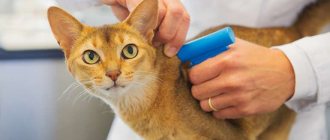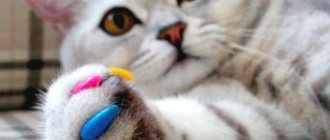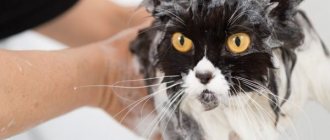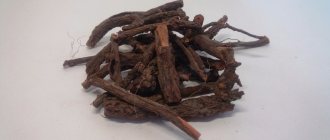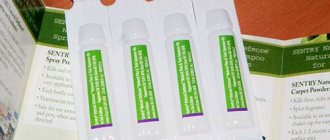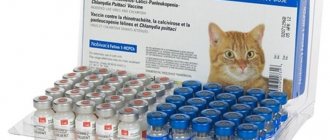Due to its versatility, the pharmaceutical drug “Levomekol” is actively used for cats. Many veterinarians give it preference, prescribing it to animals to heal wounds, suppuration and other damage to the epidermis. The correct use of the ointment is described in detail in the instructions, which you should definitely read before starting treatment.
Can it be used for bites, wounds and diseases?
Levomekol is a complex drug that is designed to accelerate the healing of wounds of various etiologies and effectively combat infections. Since the ointment has a water-soluble base, it easily penetrates the tissues and promotes their rapid cleansing of purulent contents.
The drug is used to treat all types of infected wounds and other purulent processes - boils, burns, weeping ulcers, abrasions and cuts. Despite the fact that the drug was originally intended for humans, it is successfully used to eliminate infected wounds in cats, if the need arises.
Indications for use
Levomekol is prescribed to cats in the following cases:
- cat scratches and abrasions;
- open wounds (including purulent ones);
- sutures after surgery.
Levomekol helps eliminate purulent foci (for example, wounds or fistulas). It is used to prevent infection of damaged tissues (including after surgery).
The main component of the drug is effective against staphylococci, streptococci, diplococci, salmonella, proteus, escherichia and pasteurella. It helps destroy gram-negative anaerobic bacteria. Levomycetin is active against pathogens that are resistant to antibiotics from the group of penicillins, tetracyclines and sulfonamides, drugs based on streptomycin.
Levomekol is less effective against acid-fast bacteria and clostridia, as well as protozoa.
Levomekol is often used for lichen in cats as part of complex therapy (with antimicrobial and antiparasitic agents). However, treatment with ointment should be carried out after diagnosis and identification of the pathogen. After all, outwardly, lichen resembles a skin lesion that is caused by the activity of mites during demodicosis. And with the latter pathology, the ointment is ineffective. To avoid ineffective therapy, you must first clarify the diagnosis.
Interesting! Levomekol will not help cure shingles in cats.
The ointment can help cats with otitis media (diagnosed by a doctor). It is used independently at the initial stage of pathology. And for purulent inflammation, the medicine is used as part of complex therapy.
Interesting! For otodectosis, Levomekol is ineffective.
Composition and storage conditions
The effectiveness of the drug is due to its active ingredients, including:
- Levomycetin is an antibacterial component with proven effectiveness in practice. It has a destructive effect on most pathogenic microorganisms. Resistance to it develops slowly, so it can be used for long-term treatment of wounds, burns, and cuts.
- Methyluracil is a wound-healing component of Levomekol. Thanks to this substance, metabolic processes in tissues are stimulated and their regeneration is accelerated.
The shelf life of the drug is 3.5 years from the date of release.
The medicine should be stored in a dark place at a temperature not exceeding +20°C, out of reach of children and animals.
Precautionary measures
When working with Levomecol ointment, it is important to follow general hygiene and safety rules. So, when using a medical product, you should avoid its penetration into the mouth and eyes of both yourself and the cat. After the procedure, you should thoroughly wash your hands with soap and running warm water. Antibacterial cream is applied directly to the affected areas, avoiding contact with healthy skin. It is strictly contraindicated to swallow the medicine; if this cannot be avoided, you should urgently go to a medical facility. After the expiration date, Levomekol must be disposed of and cannot be used further.
How to smear?
The ointment is intended for external use. Veterinarians recommend soaking a small gauze pad or cotton swab with the drug, applying it to the wound and covering it with a loose bandage so that the cat can move freely. Dressings need to be done every day.
If the wound is small, you can simply lubricate it with ointment, applying a thin layer of the substance 1-2 times a day. It is important to ensure that the animal does not lick the drug, otherwise the effectiveness of the treatment will be reduced.
If it is necessary to place the ointment into the resulting cavity, it is recommended to warm it up to body temperature, and then inject it into the purulent pocket using a catheter or a sterile syringe of the required volume.
The product must be used if the cat is injured, the wound does not heal for a long time, and purulent contents accumulate in it. The ointment should be used until the injury site is completely healed. Depending on the severity of the disease, treatment may take up to 10 days. The decision to discontinue the drug must be made by the veterinarian.
Medicines that a doctor may prescribe
Antibiotics are often the main treatment for a cat bite. They are used in combination with other drugs - for example, analgesics, anti-inflammatory drugs, immunostimulants.
It is possible that the doctor will prescribe topical antibiotics - for example, in the form of ointments or creams. However, systemic drugs are most often used: their effect is reliable, extensive and effective.
Antibiotics for a cat bite are prescribed in tablet or capsule form, as well as by injection. Indications for antibiotic therapy are:
- extensive and deep bites;
- blood poisoning;
- temperature increase;
- purulent processes.
With the development of purulent complications, the use of penicillin drugs is most important - for example, Amoxicillin, Ampicillin, Ampiox, etc.
Amoxicillin for cat bites is prescribed 1.5 g every 6 hours. The only contraindications may be hypersensitivity and allergy to drugs in this group.
The combination of drugs Amoxicillin and Clavulanic acid is considered effective. One of these combination antibiotics, Amoxiclav, for a cat bite, is prescribed 875 mg twice a day, or 625 mg three times a day. Side effects during treatment are usually transient. They are manifested by allergic reactions, dyspepsia, and the development of pseudomembranous colitis.
Cephalosporin antibiotics have a bactericidal effect against many types of microbes. A representative of this group, Cefuroxime, may be the drug of choice: it is used for treatment for a week.
Macrolide antibiotics, such as Tetracycline and Azithromycin, are considered the safest in terms of side effects. However, they sometimes have an adverse effect on the functioning of the digestive and urinary systems.
Antibiotic therapy is always complemented by the use of other medications. For example, to ensure an anti-inflammatory effect, Indomethacin, Celebrex, Voltaren, etc. are prescribed. And to relieve pain, analgesics such as Baralgin or Ketanol are suitable.
To eliminate swelling and prevent the development of allergies, antihistamines can be prescribed - for example, Loratadine or Suprastin.
If there is a threat of infection, rabies injections to a person after a cat bite are given not forty times, as is commonly believed, but only six times: the serum is administered on the day the cat bite is received, and then on the third, seventh, fourteenth, thirtieth and ninetieth days after it. Under no circumstances should this course be interrupted: some patients believe that one or two injections are enough to prevent rabies, but this is not so. True, vaccination can be stopped if the bitten cat continues to live and thrive 10 days after the attack on the person.
Tetanus vaccination after a cat bite is done if the patient has not had a routine DTP vaccination or its effect has already expired. In such cases, the person is again given DPT, which includes purified adsorbed tetanus toxoid. Both the administration of DTP and the injection of anti-rabies serum imply that the patient abstains from consuming any type of alcohol during the entire period of treatment, as well as for six months after the last administration of the rabies vaccine.
If the doctor deems it necessary, the administration of rabies immunoglobulin can be added to the stated course of treatment. Immunoglobulin for a cat bite is administered once, during the first day after the bite, but no later than the third day after contact. Half the dose is injected into the area around the injury, and the remaining half is administered intramuscularly (injection into the upper third of the thigh or buttock).
Such necessary immunization is usually well tolerated by patients. Allergic manifestations are found only in 0.03% of cases.
, ,
What to do if it licks it off?
In some cases, cats try to lick the ointment after application. Then experts recommend applying a bandage over the wound. But so that the animal is not constrained in its movements.
For a small pet, after applying the ointment, you can put a cotton sock with a cut-off toe on the body. Then the animal will not have access to the sore spot.
If your pet is calm, it is recommended to attach a special collar to its neck, which will not interfere with drinking and eating. You can make it yourself from thick paper or cardboard.
How to treat a domestic cat bite?
If the bite was caused by a domestic cat that you know well, who does not go outside and lives exclusively at home, then visiting a doctor, although very desirable, is not necessary: you can treat the bite site yourself. However, seeking medical help is necessary in the following situations:
- if blood oozes from the wounds and does not stop within fifteen minutes;
- if the bites are multiple and deep;
- if swelling appears, the bitten area turns red, and the temperature rises.
If the wound is superficial, the damage is minor, then you can easily deal with the problem yourself: wash the bite well with warm water and soap, dry with a clean cloth, treat with Chlorhexidine, hydrogen peroxide or any alcohol solution. Next, you should carefully monitor the damage and listen to your well-being. You should also inspect the nearest areas of the lymph nodes: during the inflammatory process, they increase first. If there are any negative changes, you should immediately visit a doctor. Self-administration of antibiotics is unacceptable: they are prescribed only by a medical specialist.
,
Side effects
Despite the benefits, in some cases the drug can cause side effects.
First of all, the cat may have an allergic reaction. The animal begins to sneeze, scratch the surface of its skin, and become restless. Therefore, immediately after starting treatment, it is necessary to monitor your pet. If an allergy occurs, the ointment should be removed with a damp cotton swab and consult a veterinarian for advice.
If the ointment gets into the cat's stomach, in rare cases, digestive system upset may occur. Therefore, it is necessary to ensure that the pet does not lick the medicine from the application site.
However, if diarrhea begins, you should give the animal ¼ of a Levomycetin tablet and provide enough fluid to avoid dehydration.
Analogs
If for some reason the use of Levomekol ointment is impossible, then other drugs can always replace it. Direct analogues of the drug are:
- "Levomethyl."
- "Netran."
These medications have the same composition as Levomekol ointment.
Indirect analogues of Levomekol include the following medications:
- "Levosin".
- "Protegentin".
- "Streptonitol."
- Ichthyol ointment.
- Vishnevsky ointment.
These drugs have a different composition, but act in a similar way. They are used to treat purulent wounds and inflammatory processes on the skin.
The cheapest replacement options are Levomethyl ointment, which costs around 50 rubles, and Vishnevsky ointment, the price of which ranges from 30 to 60 rubles.
It is worth remembering that you cannot replace the medicine yourself, without a doctor’s prescription. Only a specialist, assessing the severity of the disease, can prescribe the correct treatment.
- Classification of the pathological process
- Causes of panaritium
- Symptoms of the suppuration process
- Features of treatment
- Prevention measures
An abscess of the finger near the nail, or panaritium, is an infectious and inflammatory process that affects the periungual tissues and is accompanied by the formation of an abscess. In some cases, the inflammation spreads to the area between the fingers. Suppuration of the finger near the nail is formed as a result of the high activity of pathogenic microorganisms, which include staphylococci.
Classification of the pathological process
An abscess on the big toe and other toes downstream can be acute or chronic. Acute panaritium begins suddenly and develops quickly, characterized by severe pain in the affected area. Often provoked by high sensitivity of the skin. The finger near the nail can become sharply inflamed, which provokes vivid clinical symptoms - pain, swelling. The affected area may fester and become swollen.
Chronic panaritium is characterized by a slow course of the inflammatory process. The pain syndrome increases gradually, first the affected area swells, then suppuration forms near the nail. This condition can last for quite a long time, but you should not let it get worse; it is better to consult a doctor as soon as possible.
Causes of panaritium
The toe breaks near the nail for several reasons. These include:
- Injury, both sudden and permanent, including wearing incorrectly selected shoes.
- Exposure to aggressive chemicals.
- Thermal damage.
- Weakened immune system function.
- Inaccurate pedicure - the use of aggressive physical and chemical methods for procedures.
- Ingrowth of the nail plate into the skin of the finger.
- Fungal infection of the nails and skin of the feet.
Symptoms of the suppuration process
An abscess on the toe provokes the appearance of characteristic symptoms, which include:
- severe pain around the nail plate, intensifying even with slight pressure;
- formation of puffiness, swelling of the affected area;
- redness of the skin around the nail;
- formation and separation of pus when opening an abscess;
- local, and in some cases general, increase in body temperature;
- decreased range of motion in the foot due to pain.
How to treat bunion of the big toe
What to do if your little toe is red and hurts due to tight shoes...
Features of treatment
When a toe breaks out near the nail, treatment should consist of eliminating the pain syndrome and relieving swelling of the affected area, as well as eliminating inflammation and blocking the activity of pathological microorganisms. Only a doctor can prescribe the correct course of treatment; self-medication can lead to a worsening of the condition and complications.
If it is not possible to get an appointment with a specialist in a short time, then you should carry out some manipulations, namely:
- Warm bath with a weak solution of potassium permanganate or baking soda. The duration of this procedure should be 10 minutes. It can be repeated after 2 hours.
- To draw out the pus near the nail from the abscess, you need to apply the pulp of Kalanchoe or aloe to it. This will not only remove some of the purulent contents, but also reduce the pain of the affected area.
Reviews about the treatment
Alexander, 38 years old, Vladivostok: “Our family has long had a large cat who loves walks in the fresh air. Several times she returned home with lacerations that festered and took a long time to heal. A veterinarian I know advised me to use Levomekol to speed up healing.
Our pet resisted for several days, but then she got used to the procedures. The wounds began to heal much faster. Now this ointment is always in the home medicine cabinet.”
Marina, 58 years old, Murmansk: “We gave our grandchildren a purebred cat for a holiday, and he accidentally got hurt. The wound began to rot, and the pet became lethargic, ate poorly and refused to play.
The veterinarian at the clinic recommended lubricating the cut site with Levomekol and taught how to make dressings. The grandchildren took care of the pet themselves. After a few days, the wound healed, and the cat became active and playful.”
Andrey, 45 years old, veterinarian, Sverdlovsk: “Cats, even domestic cats, often receive various injuries. I believe that the best remedy for treating purulent wounds is Levomekol.
Thanks to its good antibacterial properties, it quickly destroys pathogenic microflora. The cats are recovering quickly. Another advantage of this drug is its low cost.”
